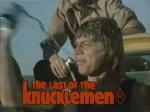AustLit

Latest Issues
AbstractHistoryArchive Description
The Last of the Knucklemen tells the story of a gang of wild-cat miners living in a camp in outback South Australia. They swear, brawl, gamble, and drink heavily. Central to the story is the conflict between Tarzan, the authoritarian group leader, and cocky, wisecracking, loud-mouth Pansy. This results in a bare-knuckle punch-up at the film's climax.
Notes
-
The trailer for this film is available to watch via YouTube: http://www.youtube.com/watch?v=bDeJ7JKNucA (Sighted: 31/8/2012)
Publication Details of Only Known VersionEarliest 2 Known Versions of
Works about this Work
-
The Larrikin Girl : Challenging Archetypes in Australian Cinema
2022
single work
criticism
— Appears in: Senses of Cinema , October no. 103 2022;'Australian cinema has travelled a varied trajectory since its initial development in the late 19th century. The cinema reflected the developing social and cultural tropes of its time, as the concept of a distinct Australian identity began to form. But it is clear that a colonial history of Australian film focuses very clearly and emphatically along lines of class and gender. Rose Lucas notes that there is a “cluster of dominant, recognisable images in our cinema” which consists of the bushman, the ocker, the ‘mate’, and the ‘battler’, a series of male coded tropes which are stubbornly pervasive within this national cinema. These archetypes have trained a concentrated gaze upon masculinity in Australian cinema, but there has been little space in this cultural landscape for the development of archetypical women in Australia’s cultural history with very few valued traits that are specifically coded female. This resolutely masculine perspective seems to have shaped the nation and the national cinema, and Lucas’s observation highlights the key archetypes as embodied as masculine. But these archetypes, long the sole domain of masculine representation, also have historically encompassed female experiences. In this paper we identify the need to broaden such a framework, and by taking the most Australian and most masculine of forms – the larrikin – we argue that the larrikin girl has been hiding in plain sight across Australian film history.' (Introduction)
-
The Larrikin Girl : Challenging Archetypes in Australian Cinema
2022
single work
criticism
— Appears in: Senses of Cinema , October no. 103 2022;'Australian cinema has travelled a varied trajectory since its initial development in the late 19th century. The cinema reflected the developing social and cultural tropes of its time, as the concept of a distinct Australian identity began to form. But it is clear that a colonial history of Australian film focuses very clearly and emphatically along lines of class and gender. Rose Lucas notes that there is a “cluster of dominant, recognisable images in our cinema” which consists of the bushman, the ocker, the ‘mate’, and the ‘battler’, a series of male coded tropes which are stubbornly pervasive within this national cinema. These archetypes have trained a concentrated gaze upon masculinity in Australian cinema, but there has been little space in this cultural landscape for the development of archetypical women in Australia’s cultural history with very few valued traits that are specifically coded female. This resolutely masculine perspective seems to have shaped the nation and the national cinema, and Lucas’s observation highlights the key archetypes as embodied as masculine. But these archetypes, long the sole domain of masculine representation, also have historically encompassed female experiences. In this paper we identify the need to broaden such a framework, and by taking the most Australian and most masculine of forms – the larrikin – we argue that the larrikin girl has been hiding in plain sight across Australian film history.' (Introduction)
- Far North South Australia, South Australia,
- Australian Outback, Central Australia,




